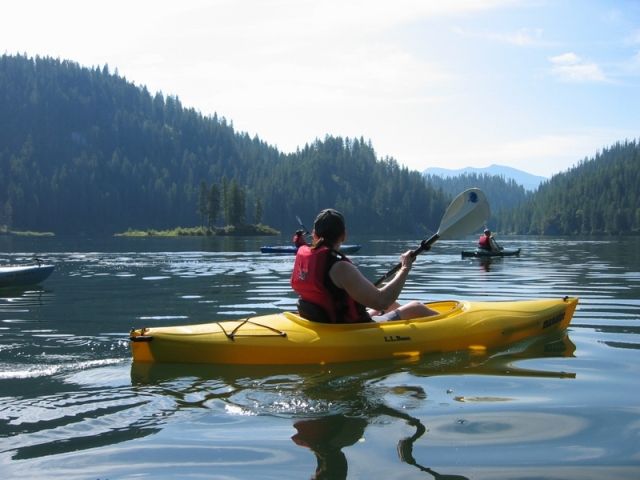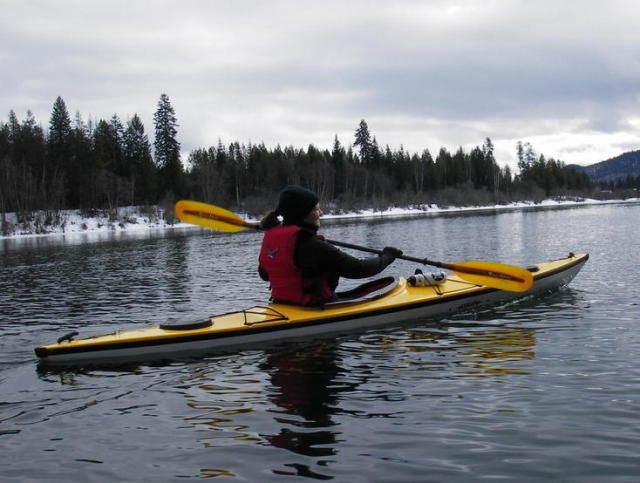If you're really looking for unsinkable, then you might want to think about a sit-on-top. I've paddled kayaks for about 20 years - from teaching technical whitewater to open-water, 17'-18' sea kayaks. <br /><br />
http://www.neckykayaks.com/kayaks/sit_on_top/vector_14/<br /><br /><br /><br /><br />Recreational kayaks (short, good for s-l-o-w moving rivers or small lakes) have little in the way of buoyancy compartments. They're fine but not intended to open water or technical moving water. Very good primary stability, virtually no secondary stability. They turn so-so and have average to poor tracking ability. Often they little consideration of a sprayskirt and in reality, it is more of a splashskirt of nylon. Short boats of this type with giant cockpits are similar to paddling an inner tube.<br /><img src="
http://www.dunhamssports.com/wp-content/uploads/2011/06/0217942350003-Vapor10.jpg" alt="" /><br /><br />Whitewater kayaks - very short (with the exception of slalom boats) and roll over very easily by design. You must be outfitted tightly to be-one-with-the-boat with mini-cell foam. You must use floatation bags inside. They turn (spin) very quickly but with little tracking ability. They have poor primary stability but excellent secondary stability. You need instruction before you climb inside a fitted boat or risk being upside, trapped and unable to exit the boat. You MUST use a good, tight neoprene sprayskirt.<br /><img src="
http://img.photobucket.com/albums/v481/paddling_man/Kayak Gear Sale/P8270019.jpg" alt="" /><br /><br /><img src="
http://img.photobucket.com/albums/v...r Sale/WendyTellicoOcoeeSternSquirtssmall.jpg" alt="" /><br /><br />Touring boats / sea kayaks: Long... true sea kayaks are a minimum of 14' and that's honestly on the cusp of being a rec boat. The have fantastic tracking though to turn one efficiently, you've got to have good edge control. The models may be optimized to different levels of primary / secondary stability. They typically have one or more sealed bulkheads providing buoyancy / storage chambers (think Titanic.) Including the cockpit, mine has four individual chambers, fore to aft. Depending on your skill and the water conditions, you may use a nylon sprayskirt, a neoprene sprayskirt or none at all. I'm using a neoprene since I can/may eskimo roll the 17 footer.<br /><br /><img src="
http://i285.photobucket.com/albums/ll62/tleigh63/P1020789.jpg" alt="" /><br /><br />Hints:<br /><br />* Old whitewater boats make poor recreational users unless you are skilled and mainly want to beach surf.<br /><br />* New fiberglass/carbon (composite) is great! Lightweight, rigid, but expensive. Old fiberglass... bad. Polyethylene is heavier and can wallow more but they are cheaper to purchase and more forgiving of rocks. Wood is BEAUTIFUL but requires care in use and ongoing maintenance.<br /><br />* Unless you're talking whitewater, longer is always better. Always. They require far less energy per mile due to their tracking ability and glide ratio. Pick the largest one that still fits within the size you want. <br /><br /><br /><br /><br /><br />Kayaks are great and can get you places other modes can't. This was from a solo island hopping, multi-day trip I did up in Superior in the Apostle Islands.<br /><img src="
http://img.photobucket.com/albums/v481/paddling_man/Apostle Islands/-080806_1633b.jpg" alt="" /><br /><br /><img src="
http://img.photobucket.com/albums/v481/paddling_man/Apostle Islands/-010680_0000a.jpg" alt="" /><br /><br /><img src="
http://img.photobucket.com/albums/v481/paddling_man/Apostle Islands/Smokeyheadingtowardcamp.jpg" alt="" />


